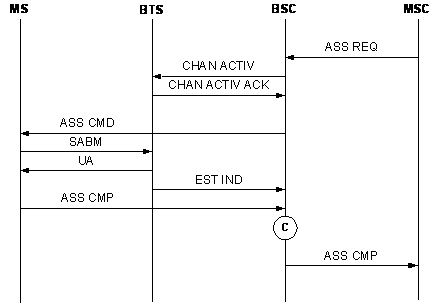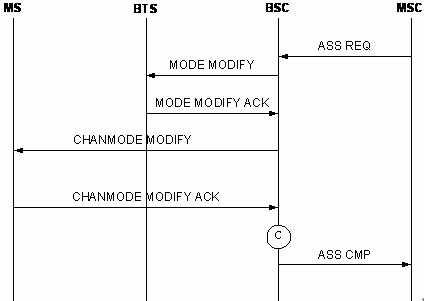Measurement Counter
A3167A: CELL_ASS_CMPL_SV1_NOT_INCLUDE_DR_TCHF
A3167B: CELL_ASS_CMPL_SV2_NOT_INCLUDE_DR_TCHF
A3167C: CELL_ASS_CMPL_SV3_NOT_INCLUDE_DR_TCHF
A3168A: CELL_ASS_CMPL_SV1_NOT_INCLUDE_DR_TCHH
A3168B: CELL_ASS_CMPL_SV2_NOT_INCLUDE_DR_TCHH
A3168C: CELL_ASS_CMPL_SV3_NOT_INCLUDE_DR_TCHH
Description
Upon receipt of an ASS REQ message, the BSC assigns a channel based on the channel type specified in the ASS REQ message and then sends a CHAN ACT message to the BTS. If the BSC receives a CHAN ACT ACK message from the BTS, the BSC considers that the channel is successfully activated. At the same time, the BSC connects the internal circuit based on the A interface CIC specified in the ASS REQ message. Then the BSC sends an ASS CMD message to the MS and waits for the MS to access the specified channel. The ASS CMD message carries the information on the ready channel, such as channel type, channel number, and frequency hopping information. The MS attempts to access the specified channel based on the channel number specified in the ASS CMD message. After successfully accessing the channel, the MS reports an ASS CMP message. Upon receipt of the ASS CMP message, the BSC sends an ASS CMP message to the MSC.
If the current cell does not have available channels and its directed retry switch is on, the BSC selects a proper adjacent cell based on the measurement report from the MS to trigger an outgoing internal inter-cell handover with the destination channel type being the traffic channel. If the handover is successful, the BSC sends an ASS CMP message to the MSC.
Suppose the MS already seizes a TCH for the signaling service in the immediate assignment procedure. When receiving an ASS REQ message, the BSC determines whether the channel mode specified in the ASS REQ message can be obtained from the channel that the MS currently seizes. If the channel mode specified in the ASS REQ message can be obtained from the channel that the MS currently seizes, the BSC enters the Mode Modify procedure and sends a MODE MODIFY message to the BTS to instruct the BTS to modify the channel mode. If the BSC receives a MODE MODIFY ACK message indicating that the BTS channel mode is successfully modified from the BTS, the BSC sends a CHAN MODE MODIFY message to the MS. After successfully modifying the channel mode, the MS reports a CHAN MODE MODIFY ACK message to the BSC. Upon receipt of the CHAN MODE MODIFY ACK message, the BSC sends an ASS CMP message to the MSC.
The counters provide the numbers of ASS CMP messages sent by the BSC to the MSC after the BSC receives an ASS CMP message or a CHAN MODE MODIFY ACK message from the MS based on the speech version and the channel type specified in the ASS CMD message or the CHAN MODE MODIFY message. The counters do not cover the number of completed assignments in the directed retry. The speech versions include full-rate speech version 1, full-rate speech version 2, full-rate speech version 3, half-rate speech version 1, half-rate speech version 2, and half-rate speech version 3. The channel type can be TCHF or TCHH.
Unit
Integer number or integer.
Measurement Point
As shown in the Figure 1and Figure 2, each time the BSC sends an ASS CMP message to the MSC after receiving an ASS CMP message or a CHAN MODE MODIFY ACK message from the MS (see measurement point C), the corresponding counter is incremented by one.
Formula
This is an original counter without involving any formula.

